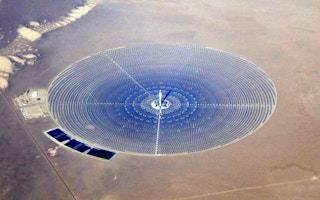Last month, the International Renewable Energy Agency (IRENA) published a report on a renewable energy “roadmap to 2050”.
The report highlighted the possibility that by 2050, about 86 per cent of the world’s power demands could be met by renewable power. It also highlighted that 50 per cent of global electricity production could be provided via renewable energy sources.
What could this mean for the six countries of the Gulf Cooperation Council (GCC), which comprises Bahrain, Oman, Qatar, Kuwait, Saudi Arabia and the United Arab Emirates (UAE)?
There seems to be a massive shift in the region’s policies towards economics, and subsequently, technology. The UAE for one has initiated the Vision 2021 programme, which includes sustainability as one of the country’s major goals—and seems to be taking it quite seriously.
“
CSP has a built-in advantage over PV, which is that as a thermal power source, it can store its solar energy cost effectively in large tanks of molten salts and therefore is a form of solar able to deliver its solar energy round the clock, not just while the sun shines.
Susan Kraemer, news editor, SolarPaces.org
The country has set a target of achieving 30 per cent of its energy needs from renewable energy by 2030. That might not be as ambitious as Denmark—a country that has slightly lesser GDP than the UAE, but has still set a goal to achieve 50 per cent of its energy from wind power.
Still, the UAE is leading in the region, especially when it comes to concentrated solar power (CSP) technology. The UAE was, until recently, the only country to have that technology in the GCC.
CSP refers to a type of solar technology that uses giant mirrors to direct sunlight on to a receiver, which converts it into heat. There are several types of such mirrors, they can be parabolic troughs or rounded dishes, or power towers.
Concentrated solar power can be a lot more effective than solar photovoltaic (PV) technology. This is because PV uses solar panels that can only work when there is sunlight, meaning electricity can only be generated as long as sunlight falls on the panels.
CSP on the other hand stores the sunlight as heat, which can be used at a later time, and even when there is no sunlight. In effect, CSP works like any other thermal power plant.
The only difference is that the heating material for all other thermal power plants is fossil fuels like oil and natural gas. In nuclear power plants, the heating agent is usually uranium.
Susan Kraemer, news editor for SOLARPaces.org, an international network for CSP research, told IPS that, “(CSP) has a built-in advantage over PV, which is that as a thermal power source, it can store its solar energy cost effectively in large tanks of molten salts and therefore is a form of solar able to deliver its solar energy round the clock, not just while the sun shines.”
A solar farm made up of PV panels would have to add a battery, to provide dispatchable energy like CSP. The batteries, Kraemer said, have a limited cycle life, and would have to be changed regularly, whereas CSP as thermal storage can be recycled indefinitely.
However, CSP does come with one disadvantage. It is more expensive than PV technology.
“The added complexity makes CSP more expensive to build than PV. However, some value in combining the two, to get both advantages: CSP is cheapest night time solar and PV for cheapest daytime solar.”
The UAE was the first from the GCC countries to get CSP technology, and is currently the only country in the GCC to have actual electricity generation through this. The UAE has had CSP since 2013—with an installed capacity of 100 MW and electricity generation of 261 GWh.
The UAE seems to be pioneering the development of CSP within the GCC countries, with one of biggest investments being the Mohammad Bin Rashid Al Maktoum Solar Park in Dubai. It boasts to be the world’s largest single site solar park—and aims to achieve 1000 MW capacity by 2020 and 5000 MW by 2030.
The owner of this park is Dubai Electricity and Water Authority (DEWA). It will, DEWA claims, have both PV and CSP technology, along with a research centre, and a solar-powered water desalination plant.
It is difficult to gauge exactly how many homes this can power because solar megawatts depend on the amount of sunlight it receives, and the angle at which the receiver is set.
However, some statistics can help. For example, Masdar states that its 10 MW and 1MW solar power plant and rooftop panels can power 500 homes for a year. How does this compare to other countries in the world?
Worldwide, there are only 19 countries to have installed capacity for concentrated solar power. Below is a comparison of the countries.
Saudi Arabia only recently acquired this technology in 2018—although it has not produced any power. Its installed capacity stands at 50 MW.
Meanwhile, the other GCC countries are either in the process of developing CSP or considering CSP options. Kuwait completed its first CSP power plant in May 2018, while Oman will have its first CSP run electricity grid by 2023.
This story was published with permission from Inter Press Service.








